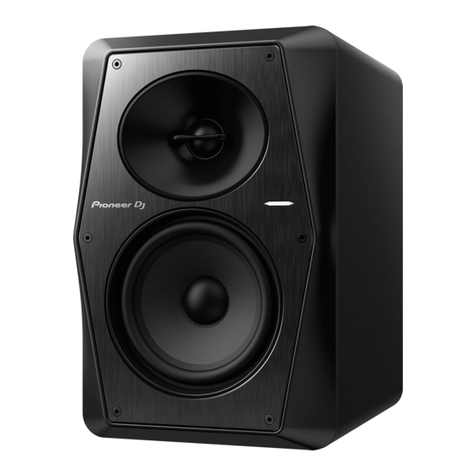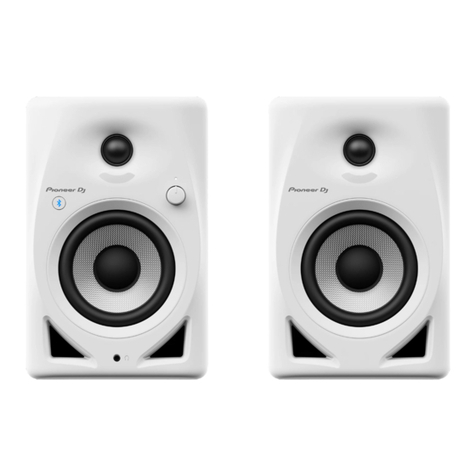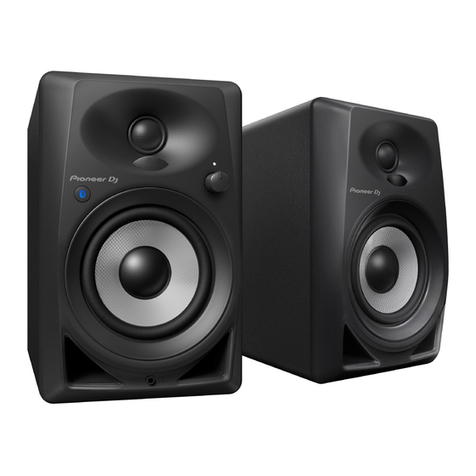
Specifications
Model XPRS102
System type Multi-purpose, 2-way active loudspeaker with
DSP controls
Transducer low 10” woofer, 2.5” voice coil
Transducer driver 1” exit compression driver, 1.75” voice coil
Frequency response
(-6 dB)
50 Hz – 20 kHz
Max SPL 129 dB
Power rating Class D 2000 W (peak)
4 DSP modes LIVE / MUSIC / SPEECH / MONITOR
Electronic protections Thermal / overload / digital Limiter /
compressor
Connectors Input: MIC / LINE (Combo) / HI-Z / LINE
(Combo) / 3.5 mm STEREO MINI
Output: MIX (XLR)
Power supply 110 V – 240 V (50 Hz / 60 Hz)
Power consumption 800 W
Enclosure construction Plywood cabinet, black paint, rubber feet,
metal handle
Mounting One standard metal pole-mount. 10 x M10
threaded inserts plus integrated pull-back
cover.
Dimensions (W x H x D) 11.77” (299 mm) x 20.5” (520 mm) x 12.2”
(310 mm)
Net weight 15.5 kg (34.2 lb)
Model XPRS122
System type Multi-purpose, 2-way active loudspeaker with
DSP controls
Transducer low 12” woofer, 3” voice coil
Transducer driver 1” exit compression driver, 1.75” voice coil
Frequency response
(-6 dB)
48 Hz – 20 kHz
Max SPL 131 dB
Power rating Class D 2000 W (peak)
4 DSP modes LIVE / MUSIC / SPEECH / MONITOR
Electronic Protections Thermal / overload / digital limiter / compressor
Connectors Input: MIC / LINE (Combo) / HI-Z / LINE
(Combo) / 3.5 mm STEREO MINI
Output: MIX (XLR)
Power supply 110 V – 240 V (50 Hz / 60 Hz)
Power consumption 800 W
Enclosure construction Plywood cabinet, black paint, rubber feet, metal
handle
Mounting One standard metal pole-mount. 10 x M10
threaded inserts plus integrated pull-back cover.
Dimensions (W x H x D) 14.28” (362.7 mm) x 25.07” (637 mm) x 13.78”
(350 mm)
Net weight 20.2 kg (44.6 lb)
Model XPRS1152S
System type 15” active vented subwoofer
Power rating Class D 4000 W (peak)
Transducer low 15” ferrite woofer, 3” (76 mm) voice coil with
long excursion
Frequency response
(-6 dB)
45 Hz – 120 Hz
Max.SPL 129 dB
DSP presets modes BOOST / EXTENDED LF / NORMAL
Crossover frequency 80 Hz / 100 Hz / 120 Hz low pass lter
Electronic protections Over heat protection / short circuit protection /
digital compressor
Cooling Temperature-controlled fan
Connectors Input: Left Mono (Combo) / Right (Combo),
Output: Left Mono (XLR) / Right (XLR)
External controls Volume control / phase switch / switch for EQ
mode selector / switch for LPF / power on with
green LED / limiter with red LED
Power supply 100 V – 240 V (50 Hz / 60 Hz)
Power consumption 800 W
Enclosure construction Plywood cabinet, black paint, metal grille with
foam, rubber feet, double handles
Mounting One standard metal pole-mount.
Dimensions (W x H x D) 22.83” (580 mm) x 17.72” (450 mm) x 19.80”
(503 mm)
Net weight 26.3 kg (57.9 Ib)
Model XPRS1182S
System type 18” active vented subwoofer
Power rating Class D 4000 W (peak)
Transducer low 18” ferrite woofer, 3” (76 mm) voice coil with
long excursion
Frequency response
(-6 dB)
40 Hz – 120 Hz
Max.SPL 130 dB
DSP presets modes BOOST / EXTENDED LF / NORMAL
Crossover frequency 80 Hz / 100 Hz / 120 Hz low pass lter
Electronic protections Over heat protection / short circuit protection /
digital compressor
Cooling Temperature-controlled fan
Connectors Input: Left Mono (Combo) / Right (XLR-F),
Output: Left Mono / Right (XLR-M)
External controls Volume control / phase switch / switch for EQ
mode selector / switch for LPF / power on with
green LED / limiter with red LED
Power supply 100 V – 240 V (50 Hz / 60 Hz)
Power consumption 800 W
Enclosure construction Plywood cabinet, black paint, metal grille with
foam, rubber feet, double handles
Mounting One standard metal pole-mount.
Dimensions (W x H x D) 26.02” (661 mm) x 21.06” (535 mm) x 21.12”
(536.5 mm)
Net weight 32.3 kg (71.2 Ib)
The specications and design of this product are subject to change
without notice.




































